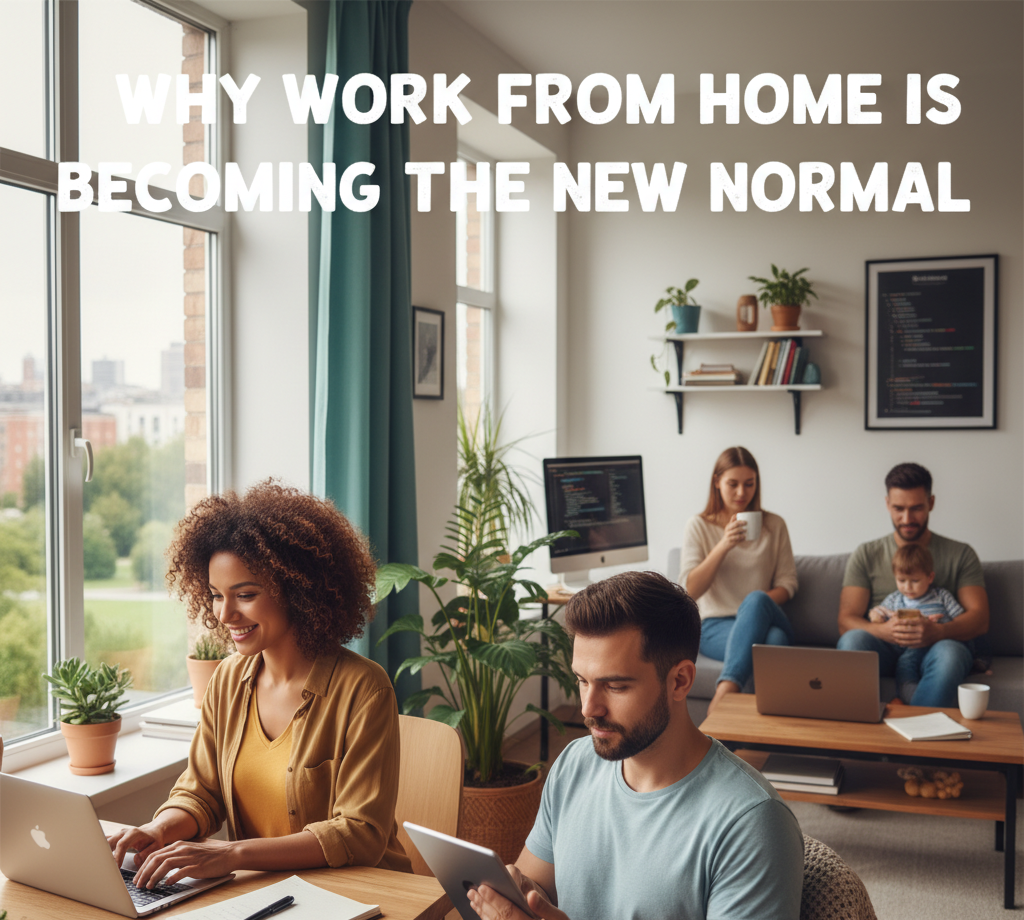Introduction
The modern office landscape is irrevocably changed. Work From Home New Normal arrangements, often blended into hybrid models, are now the standard for millions of employees globally. This permanent shift is powered by advances in tech, massive economic benefits for companies, and a major cultural demand for greater flexibility. We’ll explore the forces cementing this new normal and how businesses are adapting to thrive in a more flexible future.
This transformation is not a temporary trend. It represents a fundamental re-evaluation of productivity, talent, and business operations, permanently reshaping the global employment landscape. Today, hybrid and fully remote models dominate the discussion, proving that location-independent work is here to stay. This blog post delves deep into the forces driving this change, the profound impact on both employees and businesses, and what the future of work truly looks like. Experts project that by 2025, over 30 million professionals in the United States alone will be working remotely at least part-time, solidifying WFH’s status as the default setting for the knowledge economy. Embracing this new reality is no longer optional; it is a critical strategy for attracting top talent and ensuring business continuity.
The Catalysts of Change: Technology and Employee Demand
The abrupt global transition to remote work served as an unintended, massive-scale experiment. Thankfully, two primary forces combined to make that experiment a resounding success: leaps in digital infrastructure and an undeniable shift in employee priorities. Technology deserves significant credit for enabling this revolution. Modern tools like Zoom, Slack, Microsoft Teams, and cloud-based platforms offer seamless communication and collaboration, erasing the physical distance between team members. We can now hold high-definition meetings, share complex files, and co-edit documents in real-time, regardless of whether a colleague is across the city or across the continent. This robust digital ecosystem makes working from a home office as efficient, or in many cases, more efficient, than being in a physical office.
Beyond the technical enablers, the sheer force of employee preference drives the persistent adoption of WFH. Professionals worldwide experienced the benefits of cutting the daily commute, having greater control over their schedules, and better integrating personal needs with professional life. This improved work-life balance immediately became a non-negotiable expectation for a majority of the workforce. Surveys consistently show that flexibility now ranks as one of the most important factors for job satisfaction, often outweighing even higher pay. Many employees, especially those with family responsibilities or those seeking to reduce stress, will actively choose to leave a job that mandates a full-time office return. This collective demand for autonomy effectively swung the balance of power, forcing companies to adapt or face losing their most valuable people.
Redefining Productivity: Outcomes Over Office Hours
A major historical point of contention against remote work revolved around the myth of decreased productivity. Skeptics often worried that employees, unsupervised, would simply lose focus and produce less. However, the data overwhelmingly tells a different story. In numerous studies conducted over the past few years, a significant percentage of remote-capable workers reported that their productivity either remained stable or actually increased when working from home. This counterintuitive result stems from several key factors that fundamentally change the work dynamic.
First, the absence of an exhausting daily commute instantly grants employees valuable time and energy, which they can reinvest in their work or personal well-being. Furthermore, remote environments allow for better control over one’s working atmosphere. People can curate their space to minimize interruptions, choosing their most productive hours and settings. This shift moves performance evaluation away from the outdated metric of ‘time spent at a desk’ to a focus on tangible outcomes and clearly defined deliverables. Forward-thinking companies now emphasize clear Key Performance Indicators (KPIs) and project completion over traditional surveillance, fostering a culture of trust and self-management. This outcome-focused approach empowers employees, reducing stress and boosting overall engagement, which are the real drivers of high performance in the modern knowledge economy.
The Business Case: Cost Savings and Global Talent Access
For employers, embracing the new normal of remote and hybrid work is more than just an accommodation for staff; it represents a powerful strategic business advantage. One of the most immediate and quantifiable benefits is the massive potential for cost savings. Companies maintain huge operational budgets for commercial real estate, including rent, utilities, maintenance, and ancillary services like security and cleaning. Significantly downsizing a physical office footprint, or even eliminating it, translates directly into millions of dollars saved annually. These resources can then be strategically reallocated toward technology upgrades, employee development, or better compensation packages. Global Workplace Analytics estimates that employers can save tens of thousands of dollars per year per employee who works from home, even just part-time.
Crucially, remote work completely removes geographical barriers to hiring. This allows companies to tap into a global talent pool, dramatically expanding their options for finding the absolute best candidate for any role. No longer limited to a 30-mile radius around an expensive headquarters, a business can now hire a top-tier software engineer in a different state or a specialized marketing expert on another continent. This broad access not only secures highly skilled professionals but also drives increased diversity in thought, background, and location, making the organization more resilient and innovative. Ultimately, the ability to operate with a lower overhead while simultaneously accessing superior talent creates an undeniable competitive edge in the marketplace.

Navigating the Challenges: Culture, Collaboration, and Security
While the benefits of WFH are clear, the transition to a permanently distributed workforce is not without its complexities. Businesses must proactively address significant challenges related to company culture, team collaboration, and digital security. Maintaining a strong, cohesive company culture becomes substantially harder when employees no longer share a physical space. The spontaneous conversations, water-cooler moments, and casual lunches that naturally build camaraderie disappear. Companies must therefore deliberately replace these informal interactions with structured virtual activities, dedicated social channels, and occasional, purposeful in-person team gatherings to maintain a sense of belonging and shared mission.
Collaboration also requires a shift in approach. Remote teams rely heavily on asynchronous communication, meaning they communicate without the expectation of an immediate reply. While this aids focused work, it demands clear protocols, organized documentation, and a mindful effort to ensure all voices are heard, especially during virtual meetings. Furthermore, cybersecurity presents a constant, evolving threat. Employees working from various home networks increase the vulnerability of corporate data. Organizations must invest heavily in secure remote access technology, mandatory security training, and robust IT support to safeguard sensitive information and maintain compliance in a decentralized environment. The Work From Home New Normal and hybrid models are permanent. See how tech and economic forces mandate this change and what a flexible future looks like. Overcoming these hurdles requires a strategic, technology-driven approach that prioritizes transparent communication and accountability.
The Future is Hybrid: The Evolution of the Physical Office
Looking ahead, the most probable long-term model for the professional world is not fully remote but hybrid. This model acknowledges the profound advantages of flexible work while recognizing the inherent human need for connection and the value of in-person collaboration for certain tasks. The physical office is not vanishing; it is simply being repurposed. Instead of being a mandatory location for solo desk work, the office is evolving into a dedicated hub for connection, innovation, and team building.
In this future, office spaces will be redesigned to prioritize collaboration zones, advanced technology suites for seamless video conferencing, and flexible meeting rooms over rows of individual workstations. Employees will come in with a clear purpose, perhaps for a quarterly planning session, an intense client presentation, or a major team launch. The Work From Home New Normal is redefining business. Learn how companies are adapting to hybrid models, maximizing the benefits of flexibility and distributed talent.
This purposeful attendance ensures that in-office time is maximized for high-value human interaction, not just solitary tasks that can be done just as effectively at home. Companies that master this blend—offering flexibility while engineering meaningful, intentional in-office experiences—will define the employment success story of the next decade. The successful adoption of this hybrid standard signifies that work-from-home is indeed the new baseline expectation, with office time reserved as an intentional tool, not a mandatory routine.
Conclusion: Embracing a Sustainable and Flexible Future
The journey of work from home from an emergency measure to the established norm represents one of the most significant shifts in professional history. Driven by technological advancements, strong employee preference for a better work-life balance, and clear financial incentives for businesses, the momentum behind this change is irreversible. We are no longer debating if remote work is viable, but how to optimize it for a sustainable and equitable future.
For professionals, the key takeaway is simple: embrace flexibility, invest in your home workspace, and prioritize outcome-based performance. For businesses, the path forward requires a focus on clear digital communication, robust security, and transforming office spaces into centers for purposeful connection. By strategically adapting to the hybrid model, organizations can retain their top talent, unlock global opportunities, and reduce costs. Discover why the Work From Home New Normal is here to stay. Explore the key tech, economic, and cultural forces driving the permanent shift to a flexible work model. The era of mandatory, five-day-a-week office work is over. The new normal is flexible, digitally integrated, and fundamentally focused on empowering employees to do their best work from anywhere. This great unbinding of work from location promises a more human-centric, productive, and resilient professional world for everyone.
Find Your Dream Job Today Explore Endless Career Opportunities and Secure Your Next Role with Best Job Tool







Leave a Reply